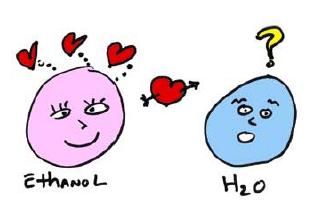We’ve written a lot of about ethanol in marine environments for some important reasons – it is “hydrophilic”.
This means it loves water and absorbs it in greater quantities than conventional gasoline [read: not good for engines]). Also, it is a strong solvent – older resin-based fuel tanks dissolve when you add even E10 to the tank. In April 2022, the Federal government announced the authorization that allows the summer sale of gasoline that has 15% ethanol (E15). Although E15 is normally prohibited between June 1 and Sept. 15 because of concerns that it adds to smog in high temperatures, the waiver is another effort to help ease global energy markets that have been rocked since Russia invaded Ukraine. This action by the government is thus praiseworthy. However, the United States Coast Guard wants boaters to be aware of the possible damages that the recently authorized fuel can cause to boats. Further, officials with the Coast Guard mention that the E15 is federally prohibited for recreational vessel use.

In short, it can’t be used in marine environments. This column is about that.
What Goes Wrong
There are a lot of things that mariners worry about when the dockhand fuels up their boat:
- Don’t put gasoline in my diesel tank!
- Don’t put diesel in my gasoline tank!
- Don’t put fuel in my water tank!
- Don’t put fuel in my marine sanitation holding tank!
And now – don’t put E15 anywhere in my boat! Why? Remember, ethanol is a solvent. If hoses and tanks do start to dissolve even in the slightest, this will lead to gumming up of all fuel lines. As water gets picked up into suspension in the hydrophilic fuel, it becomes explosive as it turns to steam in a confined area – like the valves and piston areas. All modern marine engines are designed to run up to 10 percent ethanol blend. But not E15.
What Can You Do?
First, the EPA waiver is not an effort to mandate the use of E15 but it could create confusion among the owners of boats and other non-road vehicles and that could lead to mis-fuelling. To aid the mariner, E15 can only be sold at pumps that are clearly marked, according to the EPA. But I wouldn’t be bashful about asking!
What About Winter Lay-Up – Empty or Full?
While we just came out of the winter lay-up, you’ll need to think about this eventually. And the question about the fuel system always is, “Empty or Full?” Do you drain down the fuel out of the tank for the winter or fill the tank to the top? Now, remember, ethanol is hydrophilic – it loves water. If you fill the tank up, AND you add fuel stabilizer AND you run the engine for a while so that the stabilizer makes it into your fuel lines, you will have a pretty good system. The full tank keeps condensation from forming along the sides of the tank and the stabilizer, along with the fuel itself, is fighting the solvent nature of the ethanol. Some mariners believe that draining the tanks all the way down is best, as you are not relying on the stabilizer to do a job that might be too tough over a long, cold and damp winter. I, for one, don’t buy it. Empty tanks invite condensation along the inner walls of the tank. This will be problematic in the Spring commissioning. And I remember why we used to fill the tanks in the old days – because the fumes are more likely to cause an explosion than the fuel!
But what about those hoses? That is a legitimate concern that I don’t want to minimize. Here is an idea. When changing the fuel/water separator, pour some of the gasoline, or ask your mechanic to pour some, into a clear jar and check the level of water and debris. If you see little specks in the fuel, you could have a potential ethanol problem. Those specks could be pieces of rubber fuel line that has begun to deteriorate internally.
If you find them, replace the fuel lines with a new ethanol-resistant line. A water/fuel separator can catch debris before it reaches the engine and I recommend filters with a 10-micron rating. If you use 2-micron filters, you will be changing the filters every other Saturday. 10-micron filters should be changed every 50 to 100 hours, as well as for winter layup.
And don’t let them put E15 in your boat!
BTW, if you are interested in being part of USCG Forces, email me at JoinUSCGAux@aol.com or go directly to the D1SR Human Resources Department, which is in charge of new members matters, at http://join.cgaux.org/ or, for NY/CT/North NJ/western VT, go direct to DSO-HR and we will help you “get in this thing . .
